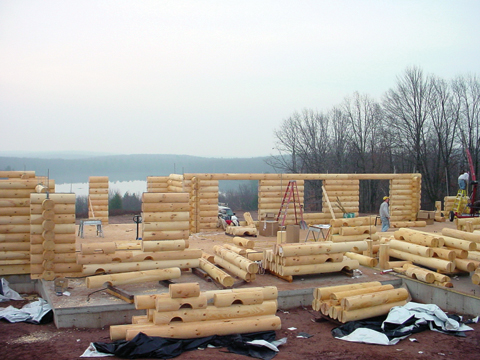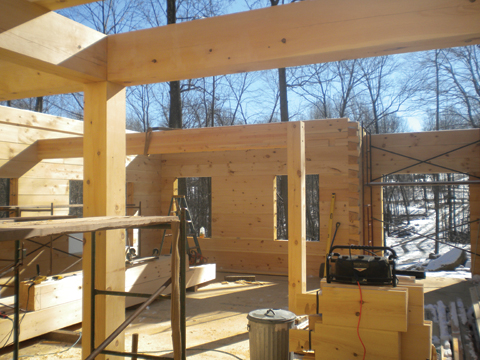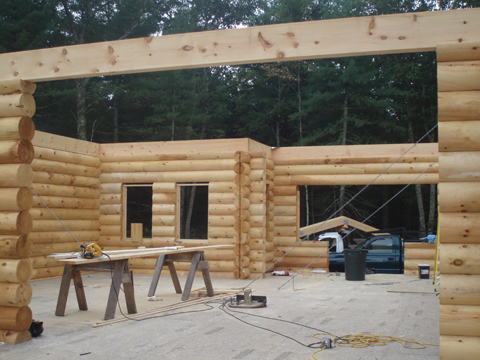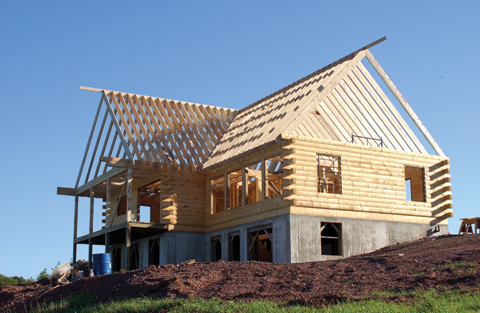The most beautiful log homes in the world all share a common bond: they started with excellent producers and builders who not only knew what they were doing, but who went the extra mile to make sure the homes exceeded their owners’ expectations.
To make sure your log home falls into this category, there are a few easy steps you can take during the planning stages. For starters, you’ll want to put the time and effort into finding a producer and builder who understand your vision, wants, and needs and who can translate them into a physical structure that truly “wows” you and everyone who visits, drives by, and enjoys your home.
Keep in mind that you’ll be purchasing materials from a log home producer, then hiring a builder to use those raw goods to bring your new abode out of the ground. “Many times what is supplied by the producer is not everything that is needed to construct your home,” says Tom Kuhns, president at Kuhns Brothers Log Homes Inc., in Milton, Pennsylvania. “So either having the producer build for you or having a very knowledgeable log home builder is very important.”

Relationships Count Jay Parmeter, president and co-owner of Golden Eagle Log Homes in Wisconsin Rapids, Wisconsin, says the first step is to find providers who are easy to work with, who return your phones calls and/or e-mail messages, and who are willing to put the time into getting your project done right. “Let’s say you call a builder and he doesn’t call you back within a day or two,” says Parmeter. “That’s a sign that he isn’t the right builder for you. If he doesn’t communicate before the sale, he won’t communicate during or after the project is done.”
Once you’ve determined whether your builder and/or producer are responsive, immediately ask for a list of past customers to call on. Drive by the homes, call the referrals, and ask about their experiences. Ask questions like: Did the finished product meet or exceed expectations? What roadblocks did you run into? Did the builder and/or producer solve the issues quickly? Would you recommend this provider to a family member?
The answers to these questions should give you an idea of whether the company in question will be a good match for your own home-building project. If you sense negativity or dissatisfaction from the other end of the phone line, move along to the next past customer. If that trend continues as you make your way down the list, it’s probably time to look at another provider. You should also check with the Better Business Bureau to ensure your producer and builder have good ratings and do not have an excessive amount of complaints.

Bids Please
Once you’ve whittled your list of builders down to a small handful of candidates, Parmeter suggests getting comparative bids from each of them. This is an important part of the home-building process, particularly for log homes. The bids not only allow you to compare builder offerings and costs, but they also give you an initial look at exactly what’s going in to your home and how much you’re going to spend on it.
When requesting bids from the builders, you’ll be asked to share some information regarding your log home, including its location, square footage, log home plan details, number of floors, special features, and other important points that will affect the construction costs. Expect to meet with the builder in person at least once before the bid is generated, and to participate in several phone or e-mail conversations during this period.
When the builders have everything they need to come up with an accurate bid, they’ll share it with you in either paper or digital format. When comparing the bids, be sure that the packages include all of the necessary documents, including a site plan, description of materials, blueprints, and contract. Compare the scope of the work outlined in the proposal and use the information to figure out if each builder is describing its duties and the project in a similar fashion. If they’re not, go back to the builder and ask for a more applicable outline of the work and the associated fees.
“You want to make sure you know exactly what you’re getting for your money,” says Parmeter. “The bidding process allows you to do that, and to compare apples to apples when making a final decision.”
There are two great articles about comparing bids on our website at www.logcabinhomes.com. The first one is “Comparing Bids from Producers”; the second is “Comparing Bids from Builders.” We highly recommend that you check them out.

Take a Trip
Dana Delano, director of sales and marketing at Ward Cedar Log Homes in Houlton, Maine, says one of the best ways to ensure that your producer and builder are a good match for your project is to get out and visit model and inhabited homes for yourself.
“The goal is to see what the logs look like once the homes are constructed, and that’s difficult to do if you don’t get out there and check them out for yourself,” says Delano, who also urges consumers to check out the firms’ manufacturing facilities. “If you’re going to spend $300,000-$400,000 (or more) on a home, what’s another $1,000 to go visit the facility to meet the engineers you’ll be working with?”
Finally, when selecting a producer or builder, Parmeter also tells consumers to ask for bank references and to inquire about the company’s solvency and creditworthiness. With the challenging economy persisting, he says, you can never be too careful about who you are doing business with. “If anyone is reluctant to hand over their banker’s name, a red flag should go up,” says Parmeter. “In today’s business environment, you have to make sure the provider(s) you’re dealing with are solvent, and that they’ll be around to finish your project.”

